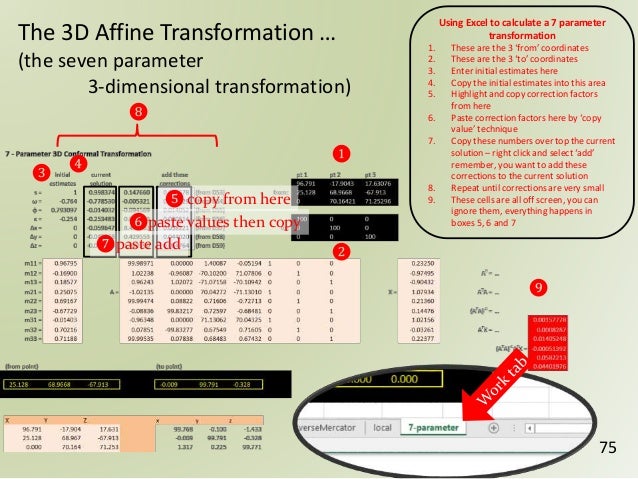7 Parameter Transformation Program

Seven Parameter Transformation Seven Parameter Transformation This transformation is a rigorous implementation of the standard three-dimensional transformation. The seven provided parameters must indicate the transformation to convert local datum coordinates to WGS84 coordinates. For many typical GIS applications, you can simply change the sign of each of the seven parameters to effect an inverse. However, this technique is not exact. For precise results, a rigorous inversion is necessary in order to determine the appropriate parameters.

Transformation works correctly in another program. 7 parameter transformation should give better result. I changed above datum transformation to Dx = 494.4090. Transformation works correctly in another program. 7 parameter transformation should give better result. I changed above datum transformation to Dx = 494.4090.
Essentially, this transformation proceeds in three phases. First, the geographic coordinates are converted to three-dimensional Cartesian, geocentric coordinates using the ellipsoid of the original datum. Second, the three-dimensional transformation defined by the seven parameters is applied producing a modified set of geocentric Cartesian coordinates. Third, the resulting geocentric coordinates are converted back to geographic form using the WGS84 ellipsoid. The seven parameters are: • Delta X: the amount the intermediary geocentric X coordinate is translated. This value must be given in meters and the direction of the translation is given by the sign of the value. • Delta Y: the amount the intermediary geocentric Y coordinate is translated.
This value must be given in meters and the direction of the translation is given by the sign of the value. • Delta Z: the amount the intermediary geocentric Z coordinate is translated. This value must be given in meters and the direction of the translation is given by the sign of the value. Secrets Of The Short Game more. • X Rotation: the amount of rotation about the X axis which is applied to the intermediary geocentric coordinates. This value is given in seconds of arc, and the direction of the rotation is indicated by the sign of the value. • Y Rotation: the amount of rotation about the Y axis which is applied to the intermediary geocentric coordinates. This value is given in seconds of arc, and the direction of the rotation is indicated by the sign of the value.
• Z Rotation: the amount of rotation about the Z axis which is applied to the intermediary geocentric coordinates. This value is given in seconds of arc, and the direction of the rotation is indicated by the sign of the value.
• Scale: a scale factor that is applied to the intermediary geocentric coordinates. The value is given as a value in parts per million and is the difference of the actual scale factor and unity. For example, a value for the scale parameter of -2.5 produces an actual scale factor of 0.9999985. That is, the actual scale factor used is arrived at by multiplying the parameter value by 1.0x10-06 and adding the result (algebraically) to 1.0.
ILWIS Download Documentation Applications This page contains information and downloadable executables or source code for: • • • The ILWIS add-ons are formally not part of the ILWIS package; questions on these tools cannot be handled by ILWIS support. Inverse Molodensky (, 326 KB) This is a tool that enables the user to find Molodensky Datum shifts (D X, D Y, D Z) between the global WGS84 reference and a local geodetic reference. The user has to provide the following input: • The latitude, longitude and ellipsoidal height of 3 points in the WGS84 system. Zawgyi One Myanmar Font here.





